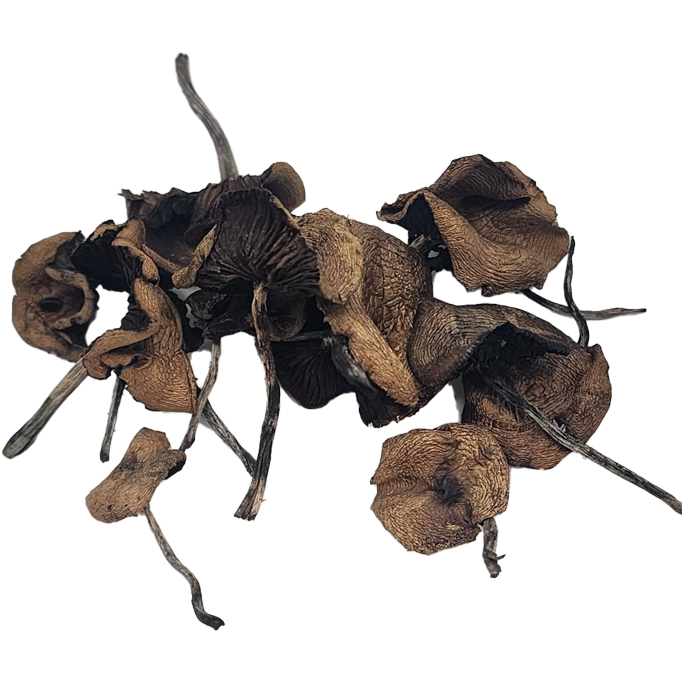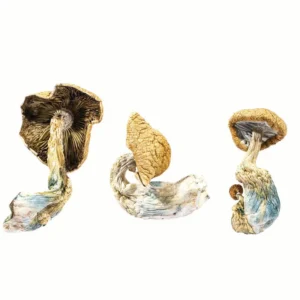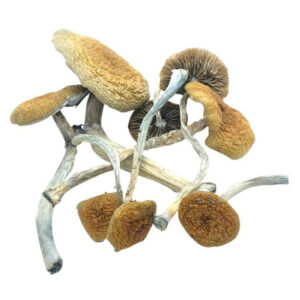Buying Magic Mushrooms Online | Pan Cyan Mushrooms
What Are Blue Meanies Mushrooms?
Paneulus cyanescens or Blue Meanie Mushroom is one of the stronger psilocybin-containing mushrooms out there, despite its relatively unassuming nature. In fact, this species is the strongest psychedelic member of the greater Panaeolus genus.
The mushrooms produced by this species are generally very small and have light gray-colored caps.
Panaeolus mushrooms — often called “mottlegills” due to the patches of color on the gills — are extremely common, but not all species of the genus contain psilocybin. They grow across the globe in several different countries, thrive in various climates, from tropical to temperate, and are capable of fruiting year-round.
Blue Meanies Shrooms Reviews
The cyanescens species of the Panaeolus genus can be found growing in grassland, heathland, and open pastures. There are around 13 other species of Panaeolus that produce psilocybin, with P. cyanescens being the most common overall.
This Panaeolus species is a bit of a “freak of nature.” Unlike other psychedelic mushroom genera, such as Psilocybe, Panaeolus species don’t normally produce psilocybin or psilocin. It’s believed that Panaeolus cyanescens started producing these tryptamines through bacterial gene transfer from nearby Psilocybe mushrooms. Both blue meanies shrooms and many Psilocybe species thrive in the same environments (grasslands and pastures).
This mushroom isn’t popular with home growers because it produces a much lower yield than Psilocybe cubensis and tends to be pickier in terms of growing conditions. This mushroom is better for the wild forager than the DIY cultivator.
The best place to find blue meanies mushrooms is in manure left behind by grazing animals. They can be hard to spot, but once you’ve found a patch, it’s a jackpot because they tend to pop up in dense clusters containing several hundred mushrooms.
Addressing the Confusion Surrounding Panaeolus cyanescens (AKA “Blue Meanies”)
The many names of this mushroom have caused a lot of confusion in the past.
The proper taxonomic name of this species is Panaeolus cyanescens. “Panaeolus” comes from the Greek word meaning “all variegated” — describing the genus’ mottled or spotted texture and coloration. The species name “cyanescens” is derived from the Greek word “cyaneus,” which means blue — describing the color the mushroom’s flesh shows once bruised.
Before the current binomial name was developed, the species was recognized as “Copelandia cyanescens” — some taxonomists still use this name today. This causes a lot of confusion because it sounds like the species is of an entirely different genus, which, of course, it’s not.
The confusion doesn’t stop with taxonomic names. Another unique species in the Psilocybe genus — Psilocybe cyanescens — is often confused with this species. Abbreviated, Psilocybe cyanescens is “P. cyanescens,” and Panaeolus cyanescens is “P. cyanescens” — you can see why people may confuse the two entirely different species.
Blue Meanie Yellow Submarine | Blue Meanie Mushroom
The most frequently used common name for Panaeolus cyanescens is Blue Meanies. The “Blue” part of the name comes from the color the mushroom bruises when damaged, and the “Meanies” part of the name describes their potency.
There are a few theories on where this name came from. Some believe it came from the “Blue Meanies” in the classic Beatles film “The Yellow Submarine,” and others assume that it came from the Australian slang term that has been used to describe magic mushrooms in general.
What’s confusing about this common name is the fact that other species can be described with it. In popular culture across the globe, the name “Blue Meanies” is often used to describe several varieties of psilocybin-containing mushrooms. There’s also a strain of Psilocybe cubensis known as “Blue Meanies,” further adding to the name conundrum.
Some people may also know this species by the common name “The Hawaiian,” which causes further confusion with another strain of Psilocybe cubensis called “Hawaiian.”
The History of Panaeolus cyanescens – Blue Meanie
The first written account of blue meanies mushroom was by Berkeley and Broome in 1871 [1]. It was identified from a sample from Sri Lanka and named “Agaricus cyanescens.”
Later, in 1887, it was scientifically listed as Panaeolus cyanescens by P.A. Saccardo [2]. Panaeolus cyanescens is the recognized taxonomic name we use today. However, when Singer named the species “Copelandia cyanescens” in 1951, the name stuck for several years — some still use it today [3].
The Copelandia genus was deprecated — this essentially means that it became invalid. All the species listed under the Copelandia genus were replaced by the name Panaeolus.
This species goes further back than its taxonomic classification. Panaeolus cyanescens is believed to have originated in Asia. The mushroom likely spread across the globe through spore transfer through the agricultural trade.
Sometime during the 1800s, cattle with the species’ spores in their fodder or manure were imported to Hawaii from the Philippines. From here, the spores likely traveled through similar trade to the mainland of the United States.
It’s believed the species was also similarly transported to Europe. Supposedly, a group of racehorses transported Panaeolus cyanescens spores into southern France from Indonesia.
Blue Meanies Effects | Blue Meanie Potency
Panaeolus cyanescens is a notoriously potent species of psychedelic mushroom — don’t be fooled by its small stature.
Many people claim that this species’ shrooms contain two to three times the amount of psilocybin than the average Psilocybe cubensis strain — though this may not be entirely correct.
In the early 1960s, Albert Hofmann — famous for being the first person to synthesize LSD (lysergic acid diethylamide) — analyzed this species, then known as Copelandia cyanescens [4]. Hofmann himself reported that these mushrooms contain far larger quantities of psilocin than psilocybin.
With higher levels of psilocin than psilocybin, fresh Panaeolus cyanescens have a faster onset of effects and a more sudden come-up.
Most studies involving blue meanie mushroom suggest its potency varies significantly. For example, a 1992 study by T. Stijve found Panaeolus cyanescens’ potency to be highly variable [5]. Stijve discovered that the average potency fell between 0.17 to 0.95% psilocin and 0.16 to 0.19% psilocybin (dry weight).
Based on the levels identified by T. Stijve, the average Psilocybe cubensis mushroom would likely be more potent — contrary to what many people report. In comparison, Psilocybe cubensis tends to have a psilocybin content of 0.5–1% and a psilocin content of 0.14–0.42% (dry weight).
Blue Meanies Dosage | Blue Meanies Shrooms Dosage
The potency of freshly harvested blue meanie mushroom is notoriously hard to gauge. It’s difficult to recommend a specific dose of these mushrooms because 1 gram from one harvest could be equivalent to 3 grams from another batch.
Most sources recommend taking a specific number of caps of Panaeolus cyanescens as a dose — but this is even less helpful.
With that said, we’ve done our best to quantify the dose as much as possible here — but it’s important to keep in mind there is no hard-fast rule here. Every mushroom harvest is going to produce different experiences.
In general, if using dried mushrooms, you’ll want to go for a 20% higher dose than you would with Psilocybe cubensis. This means that for a standard 3-gram dose equivalent of Psilocybe cubensis, you should use about 3.6 grams.
If using the fresh mushrooms, you’ll need to do essentially the opposite — use about a 20% lower dose of Panaeolus cyanescens than you would with Psilocybe cubensis. This takes into account the increased psilocin levels in the fresh mushrooms.
Dosage guide for Psilocybe cyanescens:
- Microdose: 0.1–0.5 grams
- Standard: 1–2 grams
- Strong: 2–4 grams
- Heroic: 4+ grams
Magic Mushrooms Buy Online | Blue Meanies Mushrooms Wiki
The extremely exotic, limited stock Pan Cyans Mushrooms, often referred to as Blue Meanies, are a unique and potent psychedelic mushroom species. Native to certain regions of Australia, they have gained popularity in the realm of recreational and spiritual use. Their potency makes them a subject of respect within the psychedelic community.
Blue Meanie Mushroom Effects
•Strong and vivid visual hallucinations
•Euphoria
•Lucidity
•Positive headspace
•Shifts in perspective of reality
•Changed sense of body and ego





Dorcas –
Technjh
Dorcas –
Tgfsdxx
Dorcas –
Tfszzx
Dorcas –
Tftvcc
Dorcas –
Thygtfd
Dorcas –
Ttttttt
Dorcas –
Aaaaaa
Dorcas –
Aaaaaaa
Dorcas –
Aaaaaaaa
Dorcas –
Aaaaaaaaaa
Dorcas –
Aaaaaaaaa
Dorcas –
Aaaaa